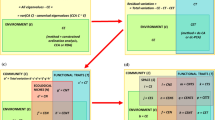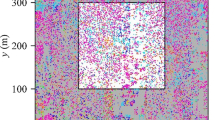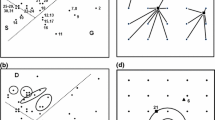Abstract
The concept of niche overlap appears in studies of the mechanisms of the maintenance of species diversity, in searches for assembly rules, and in estimation of within-community species redundancy. For plant traits measured on a continuous scale, existing indices are inadequate because they split the scale into a number of categories thus losing information. An index is easy to construct if we assume a normal distribution for each trait within a species, but this assumption is rarely true. We extend and apply an index, NOK, which is based on kernel density functions, and can therefore work with distributions of any shape without prior assumptions. For cases where the ecologist wishes to downweight traits that are inter-correlated, we offer a variant that does this: NOKw. From either of these indices, an index of the mean niche overlap in a community can be calculated: NOK,community and NOKw,community. For all these indices, the variance can be calculated and formulae for this are given. To give examples of the new indices in use, we apply them to a coastal fish dataset and a sand-dune plant dataset. The former exhibits considerable non-normality, emphasising the need for kernel-based indices. Accordingly, there was a considerable difference in index values, with those for an index based on a normal distribution being significantly higher than those from an index which, being based on kernel fitting, is not biased by an assumption for the distribution. The NOK values were ecologically consistent for the fish species concerned, varying from 0.02 to 0.53. The sand-dune plant data also showed a wide range of overlap values. Interestingly, the least overlap was between two graminoids, which would have been placed in the same functional group in the coarse classification often used in functional-type/ecosystem-function work.



Similar content being viewed by others
References
Adite A, Winemiller KO (1997) Trophic ecology and ecomorphology of fish assemblages in coastal lakes of Benin, West Africa. Ecoscience 4:6–23
Albrecht M, Gotelli NJ (2001) Spatial and temporal niche partitioning in grassland ants. Oecologia 126:134–141
Bellwood DR, Wainwright PC (2001) Locomotion in labrid fishes: implications for habitat use and cross-shelf biogeography on the Great Barrier Reef. Coral Reefs 20:139–150
Bellwood DR, Wainwright PC, Fulton CJ, Hoey A (2002) Assembly rules and functional groups at global biogeographical scales. Funct Ecol 16:557–562
Cleveland A, Montgomery WL (2003) Gut characteristics and assimilation efficiencies in two species of herbivorous damselfishes (Pomacentidae: Stegastes dorsopunicans and S. planifrons). Mar Biol 142:35–44
Cody ML (1975) Towards a theory of continental species diversities: bird distributions over Mediterranean habitat gradients. In: Cody ML, Diamond JM (eds) Ecology and evolution communities. Harvard University Press, Cambridge, pp 214–257
Day T, Young KA (2004) Competitive and facilitative evolutionary diversification. Bioscience 54:101–109
Declerck S, Louette G, De Bie T, De Meester L (2002) Patterns of diet overlap between populations of non-indigenous and native fishes in shallow ponds. J Fish Biol 61:1182–1197
Diaz S, Cabido M (2001) Vive la difference: plant functional diversity matters to ecosystem processes. Trends Ecol Evol 16:646–655
Dumay O, Tari PS, Tomasini JA, Mouillot D (2004) Functional groups of lagoon fish species in Languedoc Roussillon, southern France. J Fish Biol 64:970–983
Enquist BJ, Niklas KJ (2001) Invariant scaling relations across tree-dominated communities. Nature 410:655–660
Grinnell J (1904) The origin and distribution of the chestnut-backed chickadee. Auk 21:364–382
Hutchinson GE (1957) Concluding remarks. Cold Spring Harb Symp Quant Biol 22:415–427
Kark S, Mukerji T, Safriel UN, Noy-Meir I, Nissani R, Darvasi A (2002) Peak morphological diversity in an ecotone unveiled in the chukar partridge by a novel estimator in a dependent sample (EDS). J Anim Ecol 71:1015–1029
Kingston T, Jones G, Zubaid A, Kunz TH (2000) Resource partitioning in rhinolophoid bats revisited. Oecologia 124:332–342
Kramer DL, Bryant MJ (1995) Intestine length in the fishes of a tropical stream. 2. Relationships to diet—the long and short of a convoluted issue. Environ Biol Fishes 42:129–141
Loreau M (2004) Does functional redundancy exist? Oikos 104:606–611
MacArthur R, Levins R (1967) Limiting similarity convergence and divergence of coexisting species. Am Nat 101:377–387
Manly BJF (1994) Ecological statistics. In: Patil GP, Rao CR (eds) Handbook of statistics, vol 12. Environmental statistics. Elsevier Science, Amsterdam, pp 307–376
Manly BJF, Patterson GB (1984) The use of Weibull curves to measure niche overlap. N Z J Zool 11:337–342
Mookerji N, Weng Z, Mazumder A (2004) Food partitioning between coexisting Atlantic salmon and brook trout in the Sainte-Marguerite river ecosystem, Quebec. J Fish Biol 64:680–694
Niklas KJ, Enquist BJ (2001) Invariant scaling relationships for interspecific plant biomass production rates and body size. Proc Natl Acad Sci USA 98:2922–2927
Pianka ER (1973) The structure of lizard communities. Annu Rev Ecol Syst 4:53–74
Pickett STA, Bazzaz FA (1978) Organization of an assemblage of early species on a soil moisture gradient. Ecology 59:1248–1255
Porra RJ, Thompson WA, Kriedemann PE (1989) Determination of accurate extinction coefficients and simultaneous equations for assaying chlorophylls a and b extracted with four different solvents: verification of the concentration of chlorophyll standards by atomic absorption spectroscopy. Biochim Biophys Acta 975:384–394
Rosenfeld JS (2002) Functional redundancy in ecology and conservation. Oikos 98:156–162
Schatzmann ERG, Gerrard R, Barbour AD (1986) Measures of niche overlap, I. IMA J Math Appl Med Biol 3:99–113
Schoener TW (1989) The ecological niche. In: Cherret JM (ed) Ecological concepts. Blackwell, Oxford, pp 79–113
Shine R, Reed RN, Shetty S, Cogger HG (2002) Relationships between sexual dimorphism and niche partitioning within a clade of sea-snakes (Laticaudinae). Oecologia 133:45–53
Sibbing FA, Nagelkerke LAJ (2001) Resource partitioning by Lake Tana barbs predicted from fish morphometrics and prey characteristics. Rev Fish Biol Fish 10:393–437
Silverman BW (1986) Density estimation for statistics and data analysis. Chapman and Hall, London
Silvertown J (2004) Plant coexistence and the niche. Trends Ecol Evol 19:605–611
Stehlikova B, Gazo J, Miko M, Brindza J (2003) Fuzzy zonal analysis—a tool for evaluation of yield characters and identification of valuable plants. Biologia 58:59–63
Stine RA, Heyse JF (2001) Non-parametric estimates of overlap. Stat Med 20:215–236
Stubbs WJ, Wilson JB (2004) Evidence for limiting similarity in a sand dune community. J Ecol 92:557–567
Sugihara G, Bersier LF, Southwood TRE, Pimm SL, May RM (2003) Predicted correspondence between species abundances and dendrograms of niche similarities. Proc Natl Acad Sci USA 100:5246–5251
Tokeshi M (1999) Species coexistence: ecological and evolutionary perspectives. Blackwell, London
Venables WN, Ripley BD (2002) Modern applied statistics with S-PLUS, 4th edn. Springer, Berlin Heidelberg New York
Wainwright PC, Bellwood DR, Westneat MW (2002) Ecomorphology of locomotion in labrid fishes. Environ Biol Fish 65:47–62
Walker JA, Westneat MW (2000) Mechanical performance of aquatic rowing and flying. Proc R Soc Lond B Biol Sci 267:1875–1881
West GB, Brown JH, Enquist BJ (1997) A general model for the origin of allometric scaling laws in biology. Science 276:122–126
Wilson JB (1999) Guilds, functional types and ecological groups. Oikos 86:507–522
Wilson JB, Agnew ADQ, Patridge TR (1994) Carr texture in Britain and New Zealand: community convergence compared with a null model. J Veg Sci 5:109–116
Winemiller KO (1991) Ecomorphological diversification in lowland fresh-water fish assemblages from 5 biotic regions. Ecol Monogr 61:343–365
Winemiller KO, Kelso-Winemiller LC (2003) Food habits of tilapiine cichlids of the Upper Zambezi River and floodplain during the descending phase of the hydrologic cycle. J Fish Biol 63:120–128
Acknowledgements
Two anonymous referees and C. Koerner, the Editor-In-Chief for plant sciences, contributed to improve this article. DM was supported by grant 002420 from the University of Montpellier II on the “functional diversity of lagoon fish species”.
Author information
Authors and Affiliations
Corresponding author
Additional information
Communicated by Christian Koerner
Rights and permissions
About this article
Cite this article
Mouillot, D., Stubbs, W., Faure, M. et al. Niche overlap estimates based on quantitative functional traits: a new family of non-parametric indices. Oecologia 145, 345–353 (2005). https://doi.org/10.1007/s00442-005-0151-z
Received:
Accepted:
Published:
Issue Date:
DOI: https://doi.org/10.1007/s00442-005-0151-z




